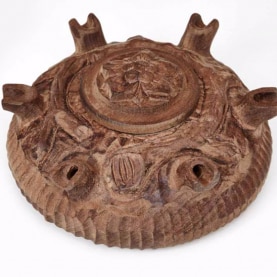Coffee today
Coffee has become one of the most widely-consumed drinks in the world. With the arrival of take-away coffee, there was a danger that its flavour would become standardised. Yet, if anything, the opposite is true. Coffee has had to adapt to the traditions, tastes and age groups of consumers. Whether coffee is consumed inside or outside the home, it is constantly being reinvented with new flavours.
The danger of standardisation
The way that coffee is consumed has changed considerably over the last few decades. Soluble instant coffee became very popular in the 1960s in many homes. Then vending machines began to appear in stations, airports and the workplace. In the 1980s, fast food quickly became popular and a disposable cup of take-away coffee could be purchased anywhere. The ceremonial and convivial rituals that had long since accompanied this beverage gradually disappeared, replaced by individualistic, ‘on-the-go’ consumption of an everyday drink. At the same time, the threat of standardised, tasteless coffee emerged.
In response to consumer demand, adaptations were made to take cultural differences into account. In Denmark, for example, where people traditionally prefer light coffee, the first vending machines to be installed offered drinks made with soluble (instant) coffee. This did not go down too well in Italy, where the taste is for more full-flavoured coffee. Therefore, to take into account consumer preferences in southern European countries, manufacturers developed machines with an integrated grinder and percolator.
Exploring new flavours
Nowadays, consumers are frequently invited to try out new flavours, be it at home or while on the go. Different varieties of coffee and beans from different regions are blended together, just like harmonising varieties of grape for wines. Great care is taken over the degree of roasting. Consumers are offered new taste experiences and as-yet-unexplored emotions.
Starbucks epitomizes the new trend that has emerged on the business side. This coffee house chain from the United States came to Europe in 1998, setting up establishments designed to offer a friendly atmosphere that would appeal to young people, who were tempted by other drinks yet somewhat resistant to the bitterness of coffee. These coffee shops offer an extensive range of coffee, from the classic espresso to caffè latte, with added flavours and spices reflecting the seasons, national specialities or festivals. This ‘lounge’ style has been widely imitated, with McDonalds, for example, creating their McCafés to also offer several types of coffee.
Tailoring tastes
We tend to drink a great deal of coffee at home. Alongside our instant coffee and traditional filter coffee makers, a new generation of coffee machines has appeared on the scene, allowing us to make quick, one-cup, as-we-please coffees. The even easier-to-use Nestlé-invented capsule coffee machines and range of different colour-coded flavours, have changed the way we drink coffee today.
Coffee with a difference
For those who love novelty, Kopi luwak, produced in the Indonesian archipelago, is a surprisingly unique premium coffee that has been on the market for the past few years. This coffee is collected from the excrement of palm civets (a mammal native to Southeast Asia), which have the peculiarity of eating red coffee ‘cherries’, while only digesting them partially. These coffee beans are then collected, washed and roasted. Due to its passage through the civet’s digestive system, the coffee loses its bitterness and is said to acquire a unique flavour. Proof, if ever it were needed, that coffee is still full of surprises!
DESMET-GREGOIRE, Hélène, 1996. De l’eau de neige au café, in BATAILLE-BENGUIGUI, Marie-Claire, COUSIN, Françoise (dir.), 1996. Cuisines Reflets des sociétés, pp.283-305, France : Editions Sépia - Musée de l’Homme.
STELLA, Alain, 1996. Le livre du café. Paris : Flammarion.
BOLOGNE, Jean-Claude, 1991. Histoire morale et culturelle de nos boissons. Paris : Éditions Robert Laffont.
PETREAULT, Clément, BROCHARD, Gilles, TOURS, Marion, FORNIER DE VIOLLET, Ghislain, DATE. Thé ou café ? Le match. Le Point [en ligne]. [Consulté le 05 octobre 2015]. Disponible à l’adresse : http://www.lepoint.fr
MATHEZ DE SENGER, Chantal, 2015. Le café, un marché en plein boom. Bilan [en ligne]. 27 avirl 2015. [Consulté le XXX]. Disponible à l’adresse : www.bilan.ch







